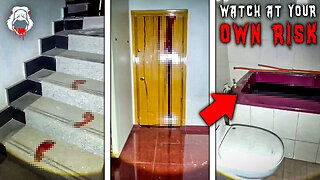Premium Only Content

Weight Training With a Physical Job (Keep Making Gains)
Weight training with a physical job
Last week I posted my video a couple of days late because I was roofing on my house, and I just ran out of time. The project was a good reminder of how hard a day can be. I’m a journeyman carpenter by trade, but I haven’t worked on the tools for years.
I know many of you are working very physical jobs. And struggle with the balance between giving 100% at work and progressing towards your fitness goals.
Clearly, someone who works a physically demanding job has to do things differently than if you work at a desk.
I’m often saying that we need to be more active, and for most of the 50 and fifty crew, this is true. But for those who do physical labour. You may need to be less active.
What I mean by this is you might need to reduce the volume of your workouts, particularly during the week. To ensure you recover and aren’t too torn down for work the next day.
I would keep the intensity high. Training close to failure, just reduce the number of sets. You can do this by cutting the number you would typically do in half, even going as low as one or two per body part.
You can increase the volume on the weekend when you have a day to recover.
Exercise selection is another thing we should think about. For example, the next day, after working on the roof, I could feel my low back, glutes and hamstrings, so deadlifting wouldn’t be a good idea.
Instead, focus on body parts that didn’t get worked as hard, like my quads choosing leg extensions over squats to protect my low back.
Another thing that helps is adding dynamic stretching into the week to ease muscle soreness and discomfort. For my low back, I like to do the cat, cow, then move straight into a lying twist with raised knees, and I finish off with a flat back to ragdoll, which is a hybrid between two movements.
First, you bend forward, keeping your back flat until you feel a good stretch in your hamstrings. Hold that for a second, then relax and allow your upper body to drop down in front of you like a rag doll. Then straighten your back again and raise into the standing position.
You’ll be amazed at how much better your back feels after doing ten reps of each exercise.
Another thing to think about is training frequency. If you find you’re not recovering when training 3 or 4 days a week, you may need to reduce the number of days down to twice a week.
We build muscle when we’re recovering, so if we need more time, we should take it.
Fatigue can accumulate over time, gradually wearing us down. This is where a deload comes in.
You may be good training for a month or two before you start to dreaded going to the gym, or you see your lifts beginning to suffer. Then you know it’s time to back off for a bit.
When I deload, I don’t stop training, and usually, it’s not a full-body deload. I find it’s one body part like my legs or low back that can’t keep up.
So I cut the weight on the exercises that affect those areas to 50% effort for a week or two until they feel ready to train.
You may need to do this for your whole body, and there is nothing wrong with taking a week off of training to recharge.
No discussion of recovery is complete without talking about sleep. We all know that we should be getting 7 to 9 hours a night.
For many, this is a matter of developing the habit of getting to bed earlier.
There was a time where I’d take a nap after work and before training to revitalize myself for my workout. For me, this worked great, but if your the type of person who has trouble getting moving again after a nap, this might not be right for you.
Let's talk about nutrition. The simplest way to reduce fatigue is to make sure we are drinking enough water and the harder you work and the hotter the day, the more water you will need. Shoot for at least 1/2 to 1 oz of water for each pound you weigh.
You need to eat quality whole foods. You should consume carbs based on activity, so people with physical jobs will require more carbs.
These are complex carbohydrates like potatoes, wild rice, oatmeal and quinoa, providing a slow, steady release of energy, unlike junk foods that give you a spike of energy followed by a crash.
If your trying to gain weight, look to see if there’s an area where your Marcos are out of balance and add foods that rebalance your nutrition.
Then watch the scale and waist measurement. If the scale starts to go up and the waist stays the same, that’s a good thing. If the waist starts going up a little, it’s okay, but it’s a sign you’re gaining some fat, so you’ll want to monitor it.
If you're trying to lose weight, cut a few calories. I suggest no more than 10% at a time until you see your weight starting to move downwards.
By eating the right foods and not doing an extreme cut, it allows you to lose weight and still have enough energy to complete your day's tasks.
We talk a lot about how important protein is to building muscle, but fats and carbs play a vital rorole too.
-
 5:31
5:31
Fit and 50
1 year ago $0.07 earnedHow Much Food to Build Muscle and Lose Fat (Including What I Eat)
5372 -
 2:22:06
2:22:06
WeAreChange
5 hours agoPSYOP Spreads: Drones Shut Down Airport In New York!
70.4K39 -
 1:31:18
1:31:18
Redacted News
7 hours agoEMERGENCY! NATO AND CIA ASSASSINATE TOP RUSSIAN GENERAL, PUTIN VOWS IMMEDIATE RETALIATION | Redacted
213K365 -
 56:45
56:45
VSiNLive
6 hours ago $5.09 earnedFollow the Money with Mitch Moss & Pauly Howard | Hour 1
68.1K2 -
 52:44
52:44
Candace Show Podcast
6 hours agoMy Conversation with Only Fans Model Lilly Phillips | Candace Ep 122
86K264 -
 LIVE
LIVE
tacetmort3m
7 hours ago🔴 LIVE - RELIC HUNTING CONTINUES - INDIANA JONES AND THE GREAT CIRCLE - PART 5
197 watching -
 26:52
26:52
Silver Dragons
5 hours agoCoin Appraisal GONE WRONG - Can I Finally Fool the Coin Experts?
32.6K2 -
 UPCOMING
UPCOMING
Bare Knuckle Fighting Championship
12 hours agoBKFC on DAZN HOLLYWOOD WARREN vs RICHMAN WEIGH IN
23.5K -
 6:49:16
6:49:16
StoneMountain64
9 hours agoNew PISTOL meta is here?
34.9K1 -
 20:58
20:58
Goose Pimples
11 hours ago7 Ghost Videos SO SCARY You’ll Want a Priest on Speed Dial
19.8K3